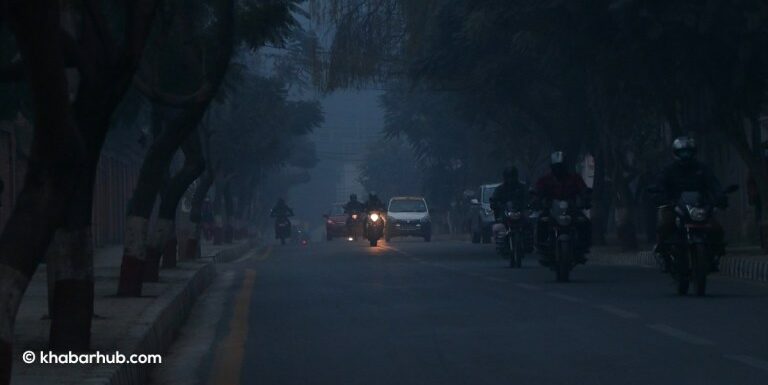0%

A view of Kathmandu street/File
KATHMANDU: The capital city of the Himalayan nation, Kathmandu, currently holds the seventh position among the world’s most polluted cities.
Live data from IQ AirVisual reveals alarming air quality levels, with PM2.5 concentrations reaching 154 micrograms per cubic meter (μg/m3) as of 2 pm today.
The PM2.5 concentration in Kathmandu is currently 12.3 times the World Health Organization’s (WHO) annual air quality guideline value, categorizing it as unhealthy.
Delhi, the capital of India, currently tops the list as the world’s most polluted city, with PM2.5 levels at 259 micrograms per cubic meter (μg/m3).
This is followed by Lahore, Pakistan, Kolkata, India, Dhaka, Bangladesh, Karachi, Pakistan, and Accra, Ghana.
Contributing Factors to Pollution in Kathmandu:
Several factors contribute to the heightened pollution levels in Kathmandu, including both human and geographical elements.
The city’s geographical location, surrounded by mountains and bordered by China and India, plays a significant role. Outdated vehicles, relying on obsolete motors and diesel fuels, emit high concentrations of pollutants.
Open burning of organic materials due to inadequate waste management infrastructure further worsens air quality.
Earthquakes, construction site dust, and the geographical location exacerbate the accumulation of pollutants, as the city lacks elevation and wind to disperse them effectively.
Types of Pollutants Found in Kathmandu:
Kathmandu’s pollution is characterized by fine particulate matter, including black carbon from incomplete combustion of fossil fuels.
Outdated vehicles, relying on diesel fuels, emit substantial amounts of black carbon, contributing to air pollution.
Other pollutants from vehicles include carbon monoxide (CO), nitrogen dioxide (NO2), ozone (O3), and sulfur dioxide (SO2).
Most Polluted Months in Kathmandu:
Analysis of 2019 data shows that the cleanest air quality occurred in August, with a PM2.5 reading of 11.8 μg/m³.
On the other hand, January to May and November to December experienced the highest pollution levels, peaking in January with a reading of 102.7 μg/m³.
Six months of the year recorded unhealthy air quality.
Health Impacts of Air Pollution:
Air pollution poses significant health risks, contributing to 7 million premature deaths annually, according to the World Health Organization.
It is associated with various health issues, including lung cancer, respiratory infections, stroke, coronary heart disease, and chronic obstructive pulmonary disease.
Vulnerable groups, such as those with heart or lung diseases, the elderly, children, pregnant women, outdoor workers, and athletes, are particularly susceptible to severe health effects.
As Kathmandu grapples with environmental challenges amid economic growth, addressing pollution sources like diesel vehicles and open burning may lead to improvements in air quality over time.